Berlin Moabit Branch, Berlin District
Roger P. Minert, In Harm’s Way: East German Latter-day Saints in World War II (Provo, UT: Religious Studies Center, Brigham Young University, 2009), 63-75.
The Moabit neighborhood of Berlin is located approximately one and a half miles north of the Tiergarten Park, or two and a half miles northwest of the city’s center. Church meetings were held at Birkenstrasse 53, in the Hinterhaus.[1] According to Armin Langheinrich (born 1926), there was a large meeting room upstairs that included a stage and an organ. “There was a bakery below, and the aroma was wonderful,” he recalled.[2]
| Berlin Moabit Branch[3] | 1939 |
| Elders | 14 |
| Priests | 9 |
| Teachers | 11 |
| Deacons | 13 |
| Other Adult Males | 40 |
| Female Adults | 158 |
| Male Children | 11 |
| Female Children | 8 |
| Total | 264 |
Moabit Branch member Wilhelm Werner (born 1916) was in uniform well before the war began. He served in the Reichsarbeitsdienst for seven months of 1938 then was drafted into the Wehrmacht. As a member of a reconnaissance battalion, he was one of the first German soldiers to cross the border into Czechoslovakia during one of Hitler’s infamous “bloodless conquests.” As Wilhelm later wrote,
The occupation of Czechoslovakia was uneventful. . . . My unit drove over the border [from Silesia] and moved without hindrance to the territory that we were assigned to take. . . . We were in Czechoslovakia for about 6 to 8 weeks. In no time we were back in Potsdam [by Berlin] where we were treated like kings and people welcomed us with flowers and parades.[4]
On September 3, 1939, Wilhelm’s unit moved from Silesia into Poland. Within a month, Germany’s war against Poland was successfully concluded, and Wilhelm was back in Berlin.
Shortly after the war started in 1939, the Moabit Branch moved into rooms at Boyenstrasse 8. Sigurd Sadowski (born 1934) remembered that in order to get to the meeting rooms, branch members had to go through one building and past one inner courtyard to a Hinterhaus that had previously been an automobile repair shop. The first rooms were a foyer, a cloakroom, and restrooms, and then came a large meeting room with seats for perhaps ninety persons. Pictures of Jesus Christ, Joseph Smith, and the Salt Lake Temple were the principal décor in the meeting hall.[5] The corner of the room was later damaged by a bomb, but Church meetings were held there all through the war.
“The war started on my birthday. I was thirteen,” recalled Armin Langheinrich. He had been in the Jungvolk since he was ten. “We learned Hitler’s biography. . . . sometimes we had to rattle [the details] off. Then we learned things similar to Boy Scouts and made knots and things. We had bicycle tours in the nearby forest.” He later became the treasurer for his Jungvolk group. He did not recall receiving any kind of military training nor missing any church meetings due to Hitler Youth activities.
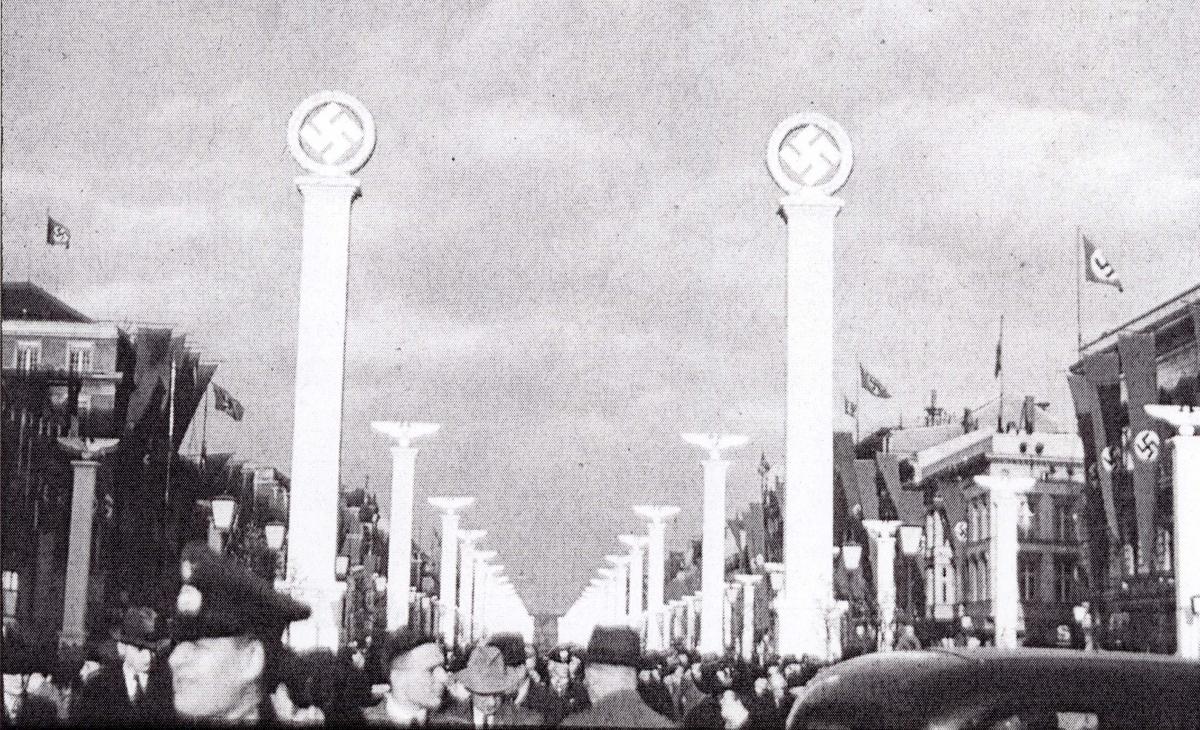 Berlin’s parade avenue Unter den Linden decked out for the 1936 Olympic Games (H. Kupitz)
Berlin’s parade avenue Unter den Linden decked out for the 1936 Olympic Games (H. Kupitz)
Armin did not begin to learn a trade at age fourteen but instead passed challenging academic examinations and was admitted to a secondary school in 1941. His school was located only ten minutes from the mission home at Händelallee 6, so, after school, he often went there to help with office duties. One of his favorite tasks was to collate pages of instruction manuals. “We laid out the sheets we had printed on ditto machines . . . around the table and over couches, and then marched around putting the pages in order.” His father, Paul Langheinrich, was the second counselor to mission supervisor Herbert Klopfer.
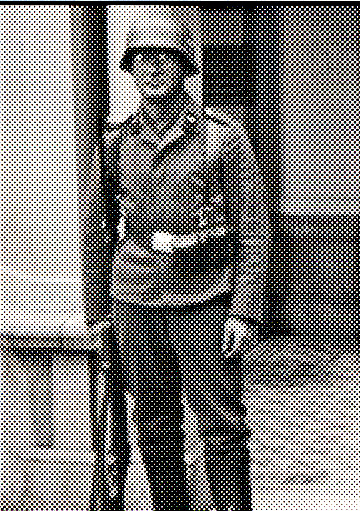 Albert Sadowski as a soldier in the Netherlands (S. Sadowski)
Albert Sadowski as a soldier in the Netherlands (S. Sadowski)
Albert Sadowski moved with his family from Dresden to Berlin Moabit in 1939, where he became branch president. The family lived in an apartment at Schwarzkopfstrasse 3, about twenty minutes walking time from church. In 1940, Albert was drafted into the air force but was released again after eighteen months because he had a work assignment in a critical war industry. The factory was secret and located underground.[6]
Early in the war, Sigurd Sadowski’s school was destroyed in an air raid. As usual, the children had all been sent home when the sirens began to wail, so nobody was in the school at the time. Sigurd later wrote:
For the schoolchildren this was both a moment of tremendous sadness and reserved joy. We were terrified that all of us could have been in the classroom when it was destroyed. On the other hand, it is a very effective way to legitimately miss a few days of school.[7]
In September 1942, at the age of eight years, Sigurd was baptized a member of the Church. “I vividly remember my baptism,” he recalled. “It occurred on a cold rainy day. The water was warmer than the outside air. The actual baptism took place in a lake outside of Berlin. My father baptized me and Brother Garland confirmed me.”[8]
During the invasion of France in the spring of 1940, Wilhelm Werner again saw action—this time it was too close for comfort when his communications unit came under fire from French artillery. He quickly crawled underneath a vehicle and later recalled what happened:
I could see and hear shells exploding around us. Then I felt a heavy thump, and all courage left me. Hot water and gasoline began raining down on me. In no time I was lying in a puddle. I rolled out from under the vehicle to see what had happened and found it in flames. Everything we possessed was burning, including my triple combination of scriptures. People said that a guardian angel was with me. . . . I know that the preserving care of God was exercised. [9]
During the summer and early fall of 1941, Wilhelm Werner’s tour of duty took him through several southeastern nations: Yugoslavia, Bulgaria, Rumania, and Greece. He enjoyed easy times and good companions, but then life became challenging again. Germany had invaded Russia in June, and Wilhelm’s unit was sent first back to Potsdam, then to the Soviet Union, where they arrived in time for the harsh winter of 1941–1942.[10]
Kurt Lehnardt, his wife, Mathilde, and their young children (four boys and a girl by 1943) made their way to Boyenstrasse 8 from the distant northern suburb of Buch. They began the trip at seven o’clock in the morning, in order to be punctual for Sunday School at ten. One of the sons, Rüdiger, remembers how his father made many visits to members who were frequently absent from the meetings—perhaps as many as thirty members each month.[11]
Mathilde Lehnardt was the mother of infants all through the war. What was a difficult time for anybody in Berlin was especially challenging for her as she tried to keep her children safe and healthy—often in the absence of her husband, who managed a power plant near their home. On May 7, 1941, their fourth son, Detlef, was born in the Moabit Hospital. At the time, air raids over Berlin were common, and just one day after Mathilde brought her infant son home, the maternity wing of the hospital that they had just left was destroyed by bombs.[12]
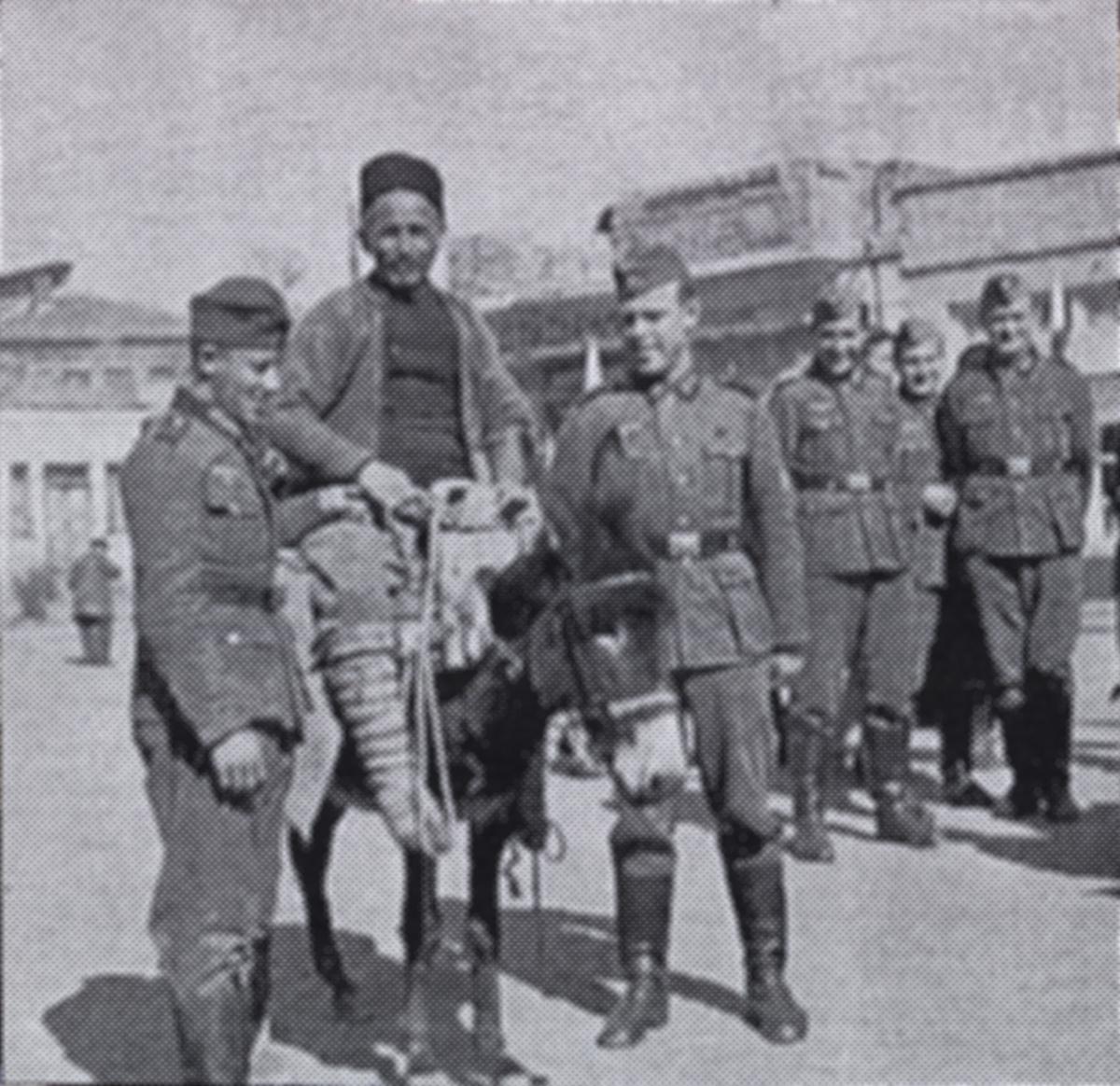 Wilhelm Werner (center) enjoyed his short stay in Greece in 1941. [W. Werner]
Wilhelm Werner (center) enjoyed his short stay in Greece in 1941. [W. Werner]
Even very little children knew the procedures to follow when the air raids over Germany’s capital city became so frequent that a night without one seemed too good to be true. According to Rüdiger Lehnardt,
When we went to bed, after us five children undressed, we had to fold up our clothes and put them on the piano: five little piles of clothes and shoes. Mother would slap us awake in the middle of the night when the sirens came, when bombers came, and then we’d have to run, put on our clothes, and line up with our shoes; we didn’t know how to tie our shoes since we were too little. So, my mother would tie our shoes for us. My dad had made a box, kind of like a serving tray with handles on it for my little sister, who was only a six-month-old baby, and so it was kind of like a baby bed that could be carried. My mom and dad would carry that. We all had our gas masks and a little backpack. Then it was always, “Hurry, hurry, hurry! The bombers are coming!” So we would run down the stairs.
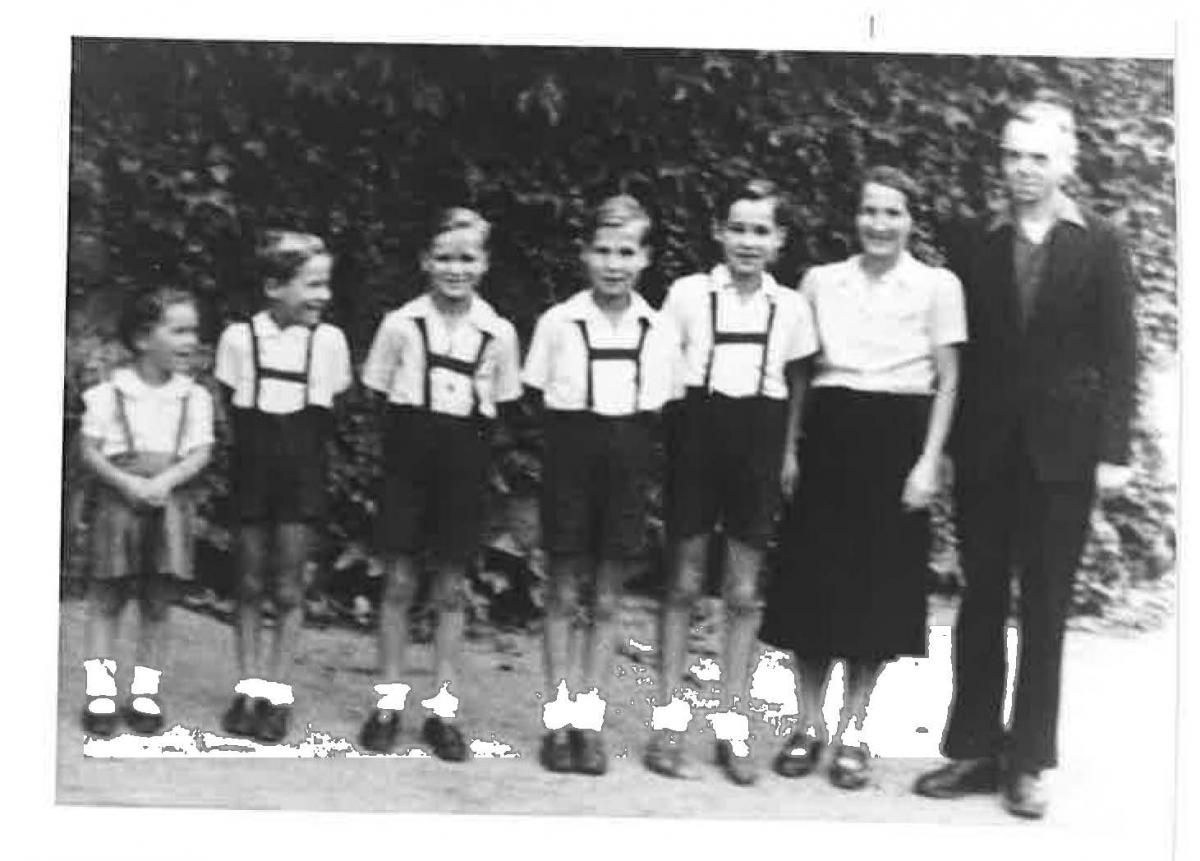 Mathilde Lehnardt with three of her children at the end of the war (D. Lehnardt)
Mathilde Lehnardt with three of her children at the end of the war (D. Lehnardt)
On several occasions, the family emerged from a bomb shelter to see buildings burning and collapsing in the immediate vicinity.
Although the Langheinrich family’s apartment on Rathenowerstrasse was not damaged, Maria Langheinrich remembered some problems: “Sometimes, when we came back to the apartment after an air raid, we found that the stovepipe in the kitchen had been knocked loose [by air shock waves] and there was soot all over the kitchen. It was terrible to clean up. That happened several times.”[13]
Armin Langheinrich’s schooling was interrupted by service to his country.
His entire class of school boys was drafted as air force assistants and assigned to work antiaircraft batteries at Humboldthain in north-central Berlin—one of the city’s three huge flak towers. The boys manned the light antiaircraft guns at the lower turrets.[14] Armin recalled, “I saw [the Americans] coming, two thousand airplanes up there!” Regarding the conditions at Humboldthain, he explained:
We had to live in those towers with the regular air force personnel, the antiaircraft people . . . and in the morning the teacher came. When it was summer, we would sit out on the grass outside for class. And sometimes we hoped for the air raid, so we could get out of class. . . . You know how young people are, we were stupid.
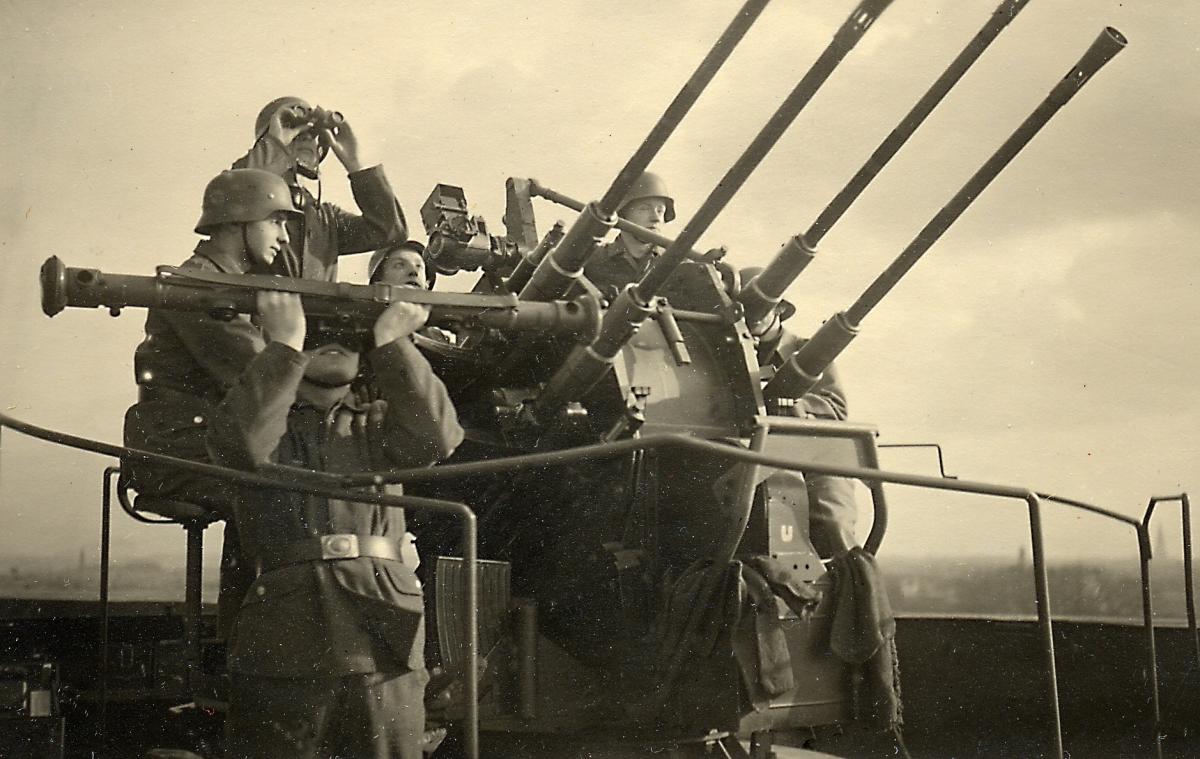 Armin Langheinrich took this photograph of his classmates at their antiaircraft battery in northern Berlin (A. Langheinrich)
Armin Langheinrich took this photograph of his classmates at their antiaircraft battery in northern Berlin (A. Langheinrich)
On May 28, 1943, Paul Langheinrich’s daughter, Maria, married soldier Erhard Wagner of the Annaberg-Buchholz Branch (Chemnitz District). They were first married officially in the city hall of Annaberg-Buchholz. As part of the ceremony, the mayor formally presented them the standard gift from the government—a copy of Adolf Hitler’s book Mein Kampf.[15] Then the couple went to the Moabit Branch meeting rooms where Friedrich Fischer, the president of the Berlin District, presided over a church wedding ceremony. Because Erhard had only enough furlough for the wedding, there was no honeymoon at the time. He returned to his unit in France while she went to her father’s home in Berlin. They would not be together again until he visited her in Berlin at Christmastime that year.
In the Soviet Union, Wilhelm Werner was in and out of combat situations for several years. As he would later write, “It seemed my fate to be present when good comrades were either wounded or killed.” On one occasion, his favorite lieutenant was hit in the abdomen by a large piece of shrapnel. The wound was severe and there was nothing the soldiers could do to help the man: “That day I lost a good friend. His death cut deep into my soul. A young, promising life was lost, and we were all helpless.” Shortly thereafter, Wilhelm was wounded when a small piece of shrapnel penetrated his left thigh. “After a tetanus shot and a few days behind the lines for rest, I was back at full duty.”[16]
One of the saddest days for the Moabit Branch involved the Werner family. At the Eastern Front, Wilhelm Werner received a numbing telegram on December 26, 1943: “Mother, Ingeborg, Franziska killed by bombs. Come home. Father.” All members of the Church, Wilhelm’s mother and his two sisters (both recently married) had died of asphyxiation in an air-raid shelter. Wilhelm was allowed to return home to attend the funeral that had been delayed by the fact that the bodies of so many air-raid victims awaited burial. A huge entourage of 400–500 members of the Church in the Berlin District attended the service. Following the funeral, Wilhelm returned to the Eastern Front. However, four months later, he was sent home to recover from depression. The war was beginning to take its toll on him.[17]
At home on Rathenowerstrasse, Maria Langheinrich Wagner remembered how her father, Paul Langheinrich, kept constant vigil during air raids. He stayed in the attic in order to locate and neutralize incendiary bombs as fast as they landed. From the roof, he threw them down to the street. In the attic, where some bombs had penetrated the roof, he dunked them into buckets of water or buried them in sand. According to Maria, he was the neighborhood hero.
By the summer of 1944, Maria Langheinrich Wagner was expecting her first child. The government and her parents encouraged her to move to her husband’s hometown of Annaberg, far from the dangers of Berlin. She found an apartment on Wohlsteingasse, and her son was born there that summer. They were fortunate to stay in that apartment through the end of the war.
In 1944, Armin Langheinrich was eighteen years of age and was drafted into an armored unit. He learned Morse code to communicate with tank crews. During the confusion of the last few months of the war, he and other recruits were constantly shifted from place to place. From Guben on the Neisse River, he was sent to the Eastern Front in January 1945. Then they moved west to Zwickau in Saxony, then north to Magdeburg near Berlin. The next move found them on the Western Front near Belgium; then they moved back into Germany to the town of Selters. Having been promised weapons with which to fight the invading Allies, they moved north to Hamburg, Rendsburg, and finally to Denmark for a week. The promised weapons were never supplied.
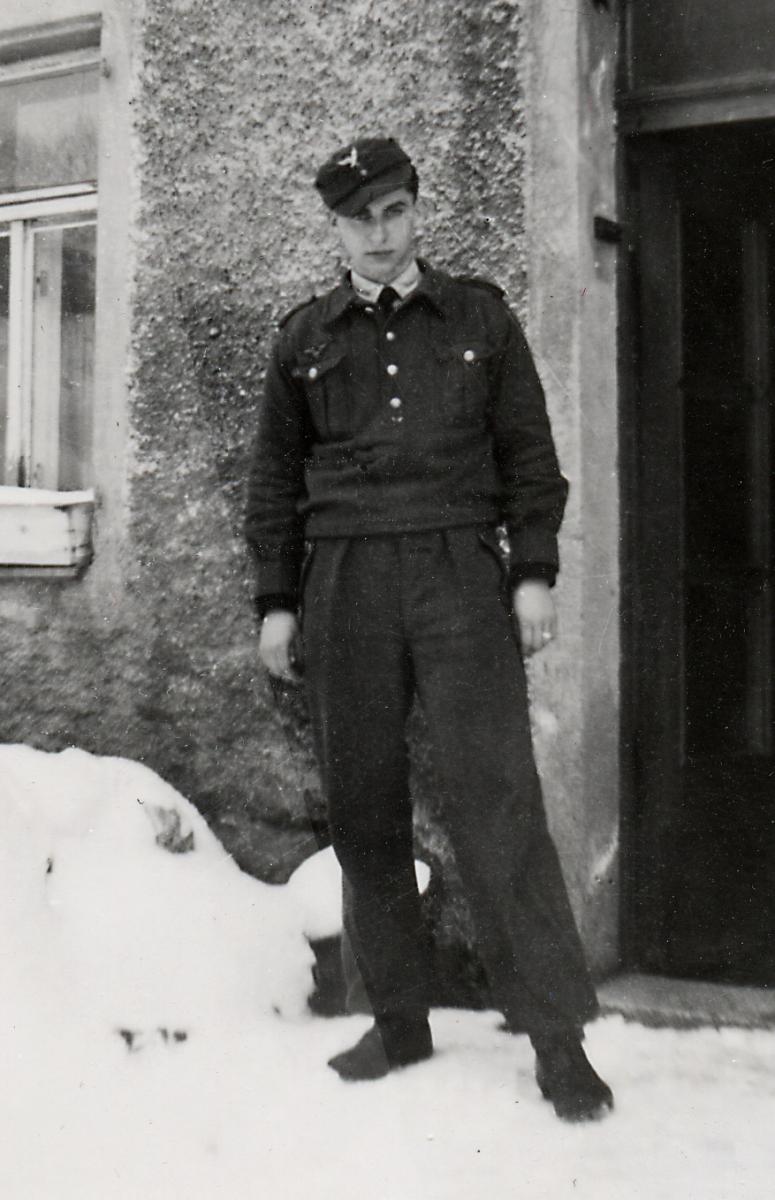 Armin Langheinrich in the uniform of a Flakhelfer (assistant antiaircraft gunner) during the winter of 1943–1944 (A. Langheinrich)
Armin Langheinrich in the uniform of a Flakhelfer (assistant antiaircraft gunner) during the winter of 1943–1944 (A. Langheinrich)
In December 1943, the Lehnardt family of Buch awaited the fifth child. Mathilde later wrote of her emotions at the time:
At first I didn’t like [being pregnant] at all. Four children and the war. We as members of The Church of Jesus Christ of Latter-day Saints believe that the spirits are waiting to be born on the earth. We shared the opportunity to experience earth life to as many spirits as possible. It wasn’t easy, but this belief strengthened me, and I awaited the baby’s arrival eagerly. . . . When the nurses told me that it’s a girl, I could hardly believe it.[20]
In February 1944, Kurt Lehnardt sent his wife and their five children east to Kreuz to escape the danger of air raids over Berlin. Mathilde and her five children arrived there after a long railroad journey and were greeted by several members of the Church. When local authorities tried to send her to a farm family out of town, she resisted, wishing to stay in town and attend church in the Kreuz Branch. Fortunately, branch president Arnold Schmidt came to her aid and insisted that she be given quarters in Kreuz. She and her children stayed there for six months.[18]
As a boy in Berlin, young Sigurd Sadowski was well aware of the possibility of dying in an air raid. On one occasion, an incendiary bomb penetrated the roof and the ceiling of the family apartment, landing on their sofa. The timer had not yet set off the fuse, so his father quickly grabbed the bomb and threw it out the window. When it ignited in the street, he said, “Well, the angels were watching us tonight.”
On several occasions after 1943, the Moabit Branch sacrament meeting was interrupted by air-raid sirens. Once, the branch president offered the benediction then everybody ran for home or the nearest air-raid shelter. Sigurd Sadowski made it home just in time:
It took us about ten minutes, running with fear in our minds and hearts, before we arrived home. We lived on the fourth floor of an apartment house. I had reached the second floor when a bomb exploded just outside our apartment house. The impact threw me and my brother Udo down half a flight of stairs and we both crashed into a wall. Wood splinters, glass, plaster, and dust were flying all around us.[19]
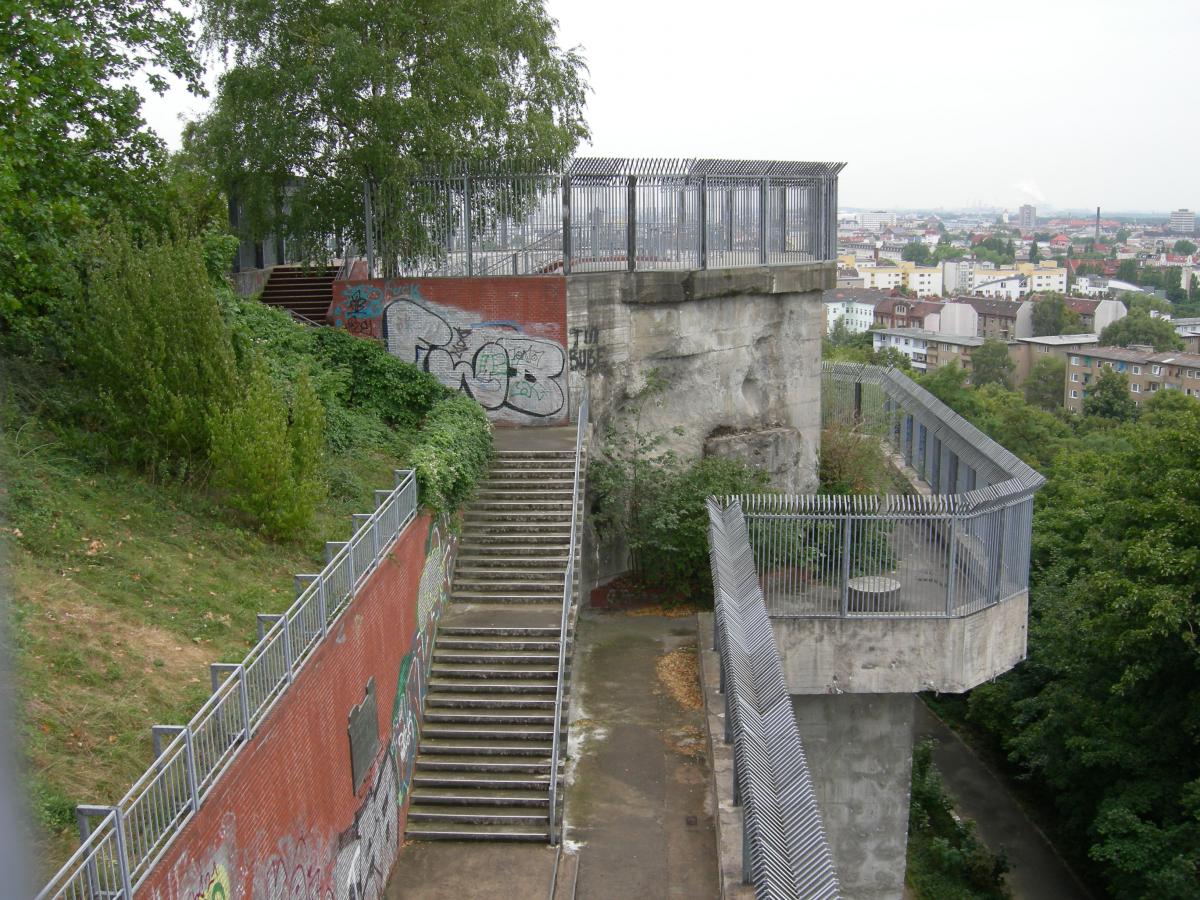 The remains of the huge antiaircraft tower at Humboldhain in Berlin as it appeared in 2008.
The remains of the huge antiaircraft tower at Humboldhain in Berlin as it appeared in 2008.
Mathilde Lehnardt did not wish to make the long journey from Buch to church on Sunday without her husband, but he was usually assigned a weekend shift at the power plant, and she had to go alone. On one Sunday in 1944, a massive air raid occurred, and she wondered how to get her five children home in safety. Along their way, they saw that homes were burning and the commuter railroad station had been destroyed. Walking several miles farther than usual, the Lehnardts reached the Pankow railroad station and were able to ride a few miles to Buch. “My sweet children were so good,” Mathilde wrote. “No one cried, even though they were hungry and tired.” Following that harrowing experience, Sister Lehnardt held Sunday School with her children at home.[21]
On July 20, 1944, Adolf Hitler narrowly escaped an assassination attempt when a bomb was placed in his conference room at Rastenburg, East Prussia. All over Germany, the news gave rise to either outrage or (premature) celebration. Wilhelm Werner wrote about that event: “August [sic] 20, 1944, an attempt was made to kill Hitler. We were jubilant, celebrating because he was dead.” Wilhelm also recalled how the jubilation subsided when it was learned that the Führer had survived the assassination attempt.[22]
Renate Berger (born 1930) and her mother from Königsberg, East Prussia, arrived in the Langheinrich home on January 28, 1945. Renate’s father, Theodor Berger, had sent them to Berlin, while he was required to remain and defend Königsberg. The LDS colony at Rathenowerstrasse 52 continued to grow over the next three months, and it is clear from eyewitness statements that a wonderful spirit of cooperation and charity prevailed in the building, despite the fact that Germany’s downfall was a foregone conclusion and death a real possibility.[23]
In the last year of the war, the Sadowski family dealt with extraordinary challenges, as described by son Sigurd:
Four months before the war ended, my father deserted [the mine] position. He returned home, where he remained always on the lookout, anticipating that he would be a target of the Gestapo [secret police]. He was always on the move to avoid detection—on flat roofs, in chimneys, attics, basements, and storage areas. It seemed to me that he received divine protection.[24]
Fortunately for Albert Sadowski’s wife, Ericka, she and her children had at least sporadic assistance from Albert as the Red Army approached, attacked, and conquered Berlin.
Somehow, Brother Sadowski found a way to serve in the Moabit Branch presidency while hiding from the police during the last months of the war. He was in great danger because fanatical Nazis were executing deserters and defeatists in broad daylight in an attempt to inspire the German populace to greater resistance against the invading Allied armies.
Sigurd Sadowski was ten in April 1945 when the street fighting in Berlin reached his neighborhood. One day, he was standing in the entry hall of their apartment building and witnessed an unforgettable event that was both horrible and comical:
A German soldier made a desperate dash across the street to enter our main hallway. He managed to make it inside our hallway, then instantly fell dead right next to where I was standing. As I carefully looked around the corner from our entrance, I saw a smiley-faced Russian giving me the “OK” sign. His “OK” signal to me was his way of communicating that he knew he had shot and killed this German soldier who had died right at my feet. This Russian soldier was a sharpshooter.[25]
The frightful sight and smell of corpses during and after the Battle of Berlin were commonplace in the memory of Sigurd Sadowski. Despite his youth, he was involved in the gruesome task of burying soldiers and civilians who had lain dead for days. His father was still hiding from the Soviets in order to avoid being taken prisoner; he only emerged now and then to help protect the women and feed families in the neighborhood. It was a daunting task.
In the apartment house at Rathenowerstrasse 52, Paul Langheinrich (functioning at the time as the first counselor in the mission leadership) had invited Latter-day Saint refugees to live in the apartments of those who had fled the city. By the end of the war, approximately forty Saints lived in what was essentially a Church dormitory. The building also housed the East German Mission office, several sister missionaries, and the family of the mission leader, Richard Ranglack. As the war came closer to his house, Brother Langheinrich became a local hero to the Saints by gathering food from many different and unexpected sources.[26] The Saints remained in that building until they located other housing in the summer of 1945.
In Rendsburg in northern Germany, Armin Langheinrich and his comrades were informed in early May that Hitler was dead.[27] They were instructed to immediately revert to the standard military salute rather than the Hitler salute they had been using (“We hated [the Hitler salute],” he explained).[28] Then they were transferred to the naval center in Kiel on the Baltic Sea. Eventually Armin ended up as a prisoner of war under the British but was released toward the end of the summer of 1945. By means of creative transportation, he returned home by his birthday in September to parents who had no idea if he was even alive. Armin Langheinrich was blessed to see less combat as a soldier on two fronts than he had seen as a flak gunner at home in Berlin.
On April 20, 1945, the Lehnardt family accepted Paul Langheinrich’s invitation to move into the LDS refugee colony at Rathenowerstrasse 52. They made their way downtown and were received warmly. The next day, Kurt went home, planning to bring more of their clothing to the Rathenowerstrasse. However, when he arrived home, the Red Army was already there; the enemy soldiers detained him, and he did not see his family again for a week.[29]
Rüdiger Lehnardt first saw an enemy soldier from a window in that building. He later said this about the incessant bombings in the last ten days of the war, “It’s a complete miracle—I feel very blessed not to have been killed during those last days of the war.”
The last Sunday meeting of the Moabit Branch before the war ended took place on April 22, 1945. Helga Meiszus Birth, a member of the Tilsit Branch serving as a missionary since October 1944, recorded the following in her diary:
Nobody was certain if there would be church meetings today. I got dressed and headed for the North [Moabit] Branch. It was raining very hard on us as we walked. The terrifying noise of the flak accompanied us to church. Nobody was there except for Brother Ranglack, Brother Langheinrich, Brother Newer, two sisters, and me. For the first time ever, our meeting began late because we waited for more members to arrive. Werner [Ranglack] came and had to substitute as the organist. Even though we were few in number, the spirit was strong. “Where two or three of you are gathered in my name, I will be with you.”[30]
On Friday, April 27, 1945, Renate Berger began a diary. Years later, she explained why she did so:
My mother made me write a journal during the last few days of the war. There was nothing for us to do but to think about the horror that was to come upon us, and pray. We had been through so much and lived with the reality of death for the last 6 years. . . . Now my greatest fear was not dying but falling into the hands of Russian soldiers. So here we were, and the Russians were coming. We prayed. Our fate was in God’s hands. I was 17 years old.[31]
What Renate wrote survived and constitutes a monument to the faithfulness of the members of the LDS refugee community at Rathenowerstrasse 52. The following are just a few of the entries she made in her diary from April 27 to May 10, 1945:
Friday, 27 April: Great anxiety rests over all of us. The brethren suggested to come together in prayer and fasting. We prayed for strength and protection as we face the uncertainty of things to come.
Saturday, 28 April: Helga [Meizsus Birth] and I spotted the first 2 Russian soldiers as we looked out a window. The first ones we saw were Mongols and a frightening sight to behold with guns in their arms and knifes [sic] in their mouths.
Werner Ranglack told me in the afternoon that I would have to give a lesson during Sunday School tomorrow. I did not have much time and had to block out everything around me and focus on studying and preparing.
Sunday, 29 April: Sunday School started at 11:00 a.m. 29 adults and 13 children were in attendance. . . . While we were conducting Sunday School, the city was under air attacks, heavy and frequent with increasing intensity. We could hear the by then familiar sound of falling bombs. . . . The ground would shake with each hit. I cannot believe that we are still alive. Are we destined to survive? . . . Then at 4:00 pm it was time to meet again for sacrament meeting. 32 attended.
Monday, 30 April: Angela [Patermann] and I took care of the children today. We prayed with them and kept them busy so they would not focus on what was going on outside. It was not an easy job. . . . We did not receive daily miracles of loaves and fishes but somehow we always had enough to get by. Today we had all the ingredients to make candy. So that is what we did.
Tuesday, 1 May: We had Relief Society in the afternoon. Marie Ranglack gave the lesson. Now during this time all the shooting and heavy artillery fire had stopped. It was very peaceful when all of a sudden a bomb exploded in the building next to ours. The air pressure was so strong that we were thrown off our chairs. Shell fragments came flying through the windows. It was a miracle that no one was hurt. It took our breath away. Another close call!
Wednesday, 2 May: Could it be? Word spread through the neighborhood that the war has ended. We were at PEACE! . . . We did not feel a jumping up and down kind of joy. . . . Will we see our fathers, husbands, and sons again?[32]
[Late tonight] We were startled when Elsa Langheinrich suddenly opened our door and said: “Children, the Russians are coming.” What now? We quickly dressed. During that time 3 Russians were already in the kitchen, and we heard them going from room to room. . . . [There was no room under the bed.] So we crawled into bed and covered ourselves with a big feather bed and then we waited. . . . Then the door opened and we heard steps coming to our bed. We were sweating “blood and water”; then someone lifted the feather bed. We were horrified. When I opened my eyes I saw Brother Patermann standing there. What a joy it was to see his smiling face. . . . We said a prayer of thanks before we went to sleep.
Thursday, 3 May: Helga and I were proofreading genealogical records. We did not accomplish much, just acted silly and giggled all afternoon and consumed at least 1 pound of candy. It was good to be able to laugh again.
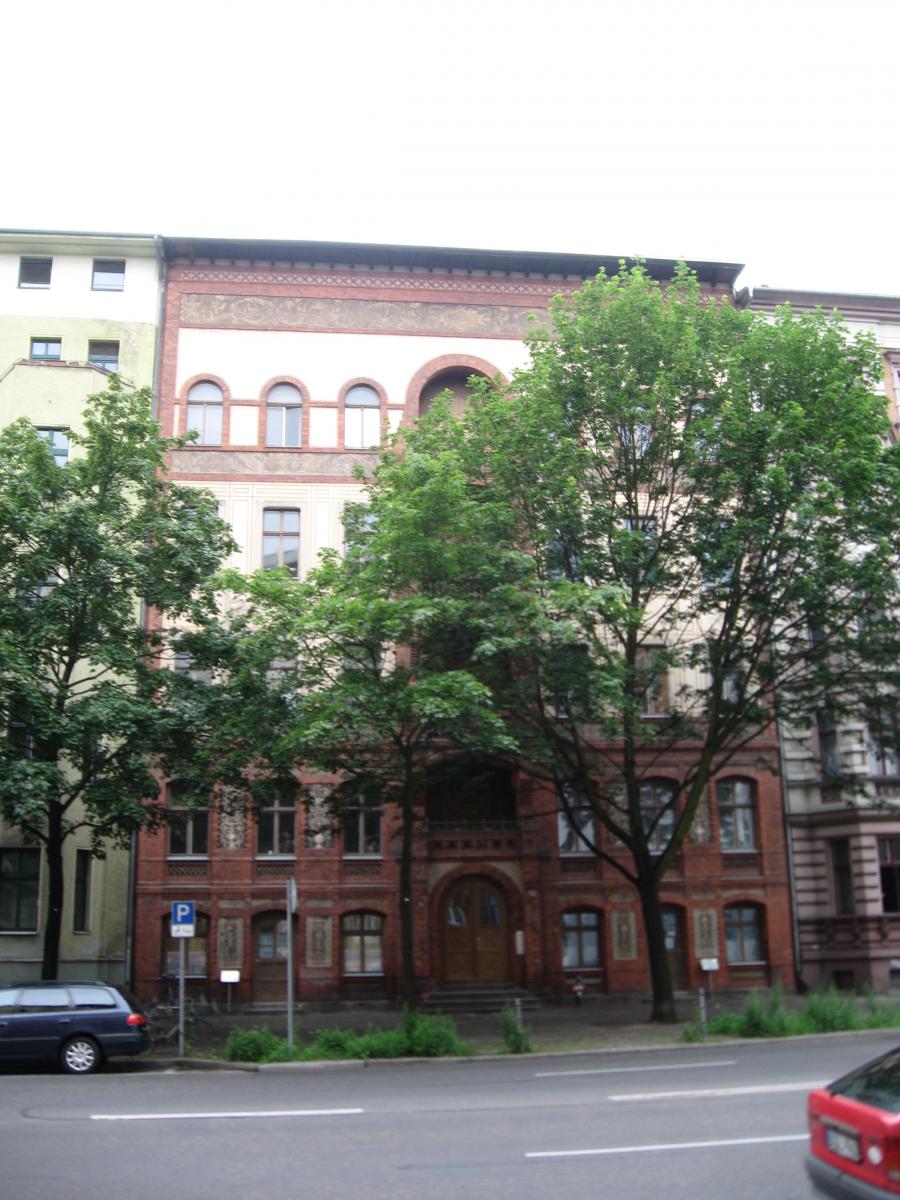 By the end of the war, the apartment house at Rathenowerstrasse 52 housed several refugee LDS families (J. Larsen, 2007)
By the end of the war, the apartment house at Rathenowerstrasse 52 housed several refugee LDS families (J. Larsen, 2007)
On May 11, Mathilde Lehnardt and her five children made the trek from the Langheinrich apartment building back home to their northern suburb of Buch. It was a walk of about six miles that they accomplished in five hours, including an adventuresome crossing of the extensively damaged Fenn Street bridge. Their home had been taken over by Russian soldiers, so Kurt had to put his family up in an abandoned apartment for a few weeks. However, the war was over, and the Lehnardt family had survived it intact.[33] According to son Detlef, “Our home had been only slightly damaged when an incendiary bomb plummeted through the roof into the apartment. Fortunately, neighbors were able to quickly break down the door and throw the bomb out of the window before a fire could break out.”[34]
The former capital city of Hitler’s Third Reich slowly came back to life in the summer of 1945, and with the end of the war, the Moabit Branch members gathered from their hiding places in the basements of bombed-out buildings as well as from various parts of the continent. The Saints who had survived the ordeal gave credit to God for their deliverance. Although the war had taken many victims from among the membership of the branch, the survivors looked forward to better times.
One day after Germany surrendered and the war officially ended, Wilhelm Werner became a prisoner of war of the Soviets. His unit had survived until the end, mainly because the invaders bypassed his position on the coast of the Baltic Sea as they moved quickly toward the Reich capital. Over the next few months, Wilhelm’s captors moved him around East Prussia and finally to a POW camp near Moscow, Russia. It was difficult to become accustomed to life in such a camp, where survival was the primary concern and all of the comforts of life appeared to have been carefully removed. Regarding conditions in the camp lavatory, for example, he wrote the following description years later:
Into the seating platform there were about twenty-five round holes to accommodate nature. These were small enough that we couldn’t fall in. There were no doors on the side and no roof, allowing snow, ice, rain, wind, and sun heat to invade our facility. Openly exposed derrieres had to adjust to the prevailing climatic conditions. Other sanitary conveniences were hard to come by, or were nonexistent. If there was any kind of bashfulness, shame, or humiliation, those feelings were completely suppressed during our confinement.[35]
From 1945 through 1949, Wilhelm Werner lived in various POW camps in central Russia, where he worked constructing buildings and highways. On several occasions, he became seriously ill and remained ill for months on end. One bout of diarrhea tortured him for six months. “There are no words to explain how dreadful my circumstance was. I was loosing [sic] weight and was already as thin as a beanstalk.”[36] With minimal medication and care, he somehow survived each illness.
As horrible as Wilhelm’s living conditions were in the Russian POW camps, the mental torture was worse, especially after four full years of incarceration. He later described it in these words:
Mental torture was considered worse than the physical tortures. The Russians nurtured mental stress by maintaining a state absent of surety: What am I doing? What’s happening? Did [other soldiers who left the camp] go home? That was the system.[37]
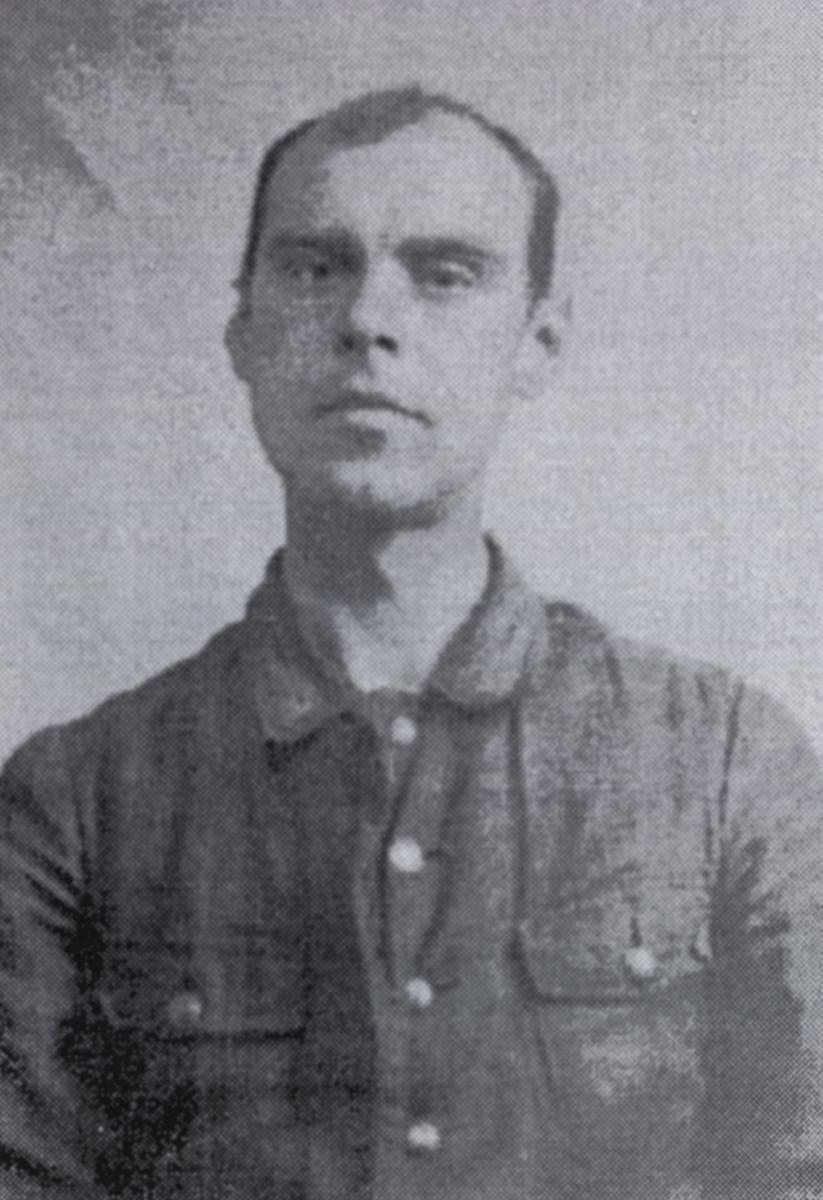 Wilhelm Werner as a prisoner of war in Russia in about 1948 (W. Werner)
Wilhelm Werner as a prisoner of war in Russia in about 1948 (W. Werner)
Finally, in November 1949, Wilhelm Werner was released from prison and transported to Germany. Arriving in Berlin on November 13, he underwent a medical examination and was given some money. He also received some canned food with the brand name Deseret. “That means we were beneficiaries of LDS Church aid for the war refugees of WW II,” he concluded. He noted the stark contrast between East Berlin (the Soviet Occupation Zone) and West Berlin (occupied by British, French, and American forces):
In the West, people were building, the lights came on, rubbish was removed, the city cleaned-up, restaurants were open, and movie houses were running. The streets in the East were full of rubbish, and the lights were still out, making the ruined buildings dark and uninviting. There was a very obvious difference between the progress made in rebuilding the West versus the East.[38]
Wilhelm made his way to Spandau, a suburb at the far northwest edge of West Berlin. Turning his back on East Berlin and communism, he found himself a job with the West Berlin police. A new life began for Wilhelm Werner.
In Memoriam
The following members of the Berlin Moabit Branch did not survive World War II:
Karl Hubert Allin b. Friedland, Schlesien, Preussen 6 Sep 1890; son of Joseph Allin and Louise Auguste Wiesner; bp. 6 Jun 1925; d. 1944 (CHL CR 375 8 #2458, 726–727; IGI)
Otto Bauer b. Biskupitz, Posen, Preussen 12 May 1918; son of Philipp Bauer and Luise Wilhelmine Kuhn; bp. 16 May 1931; conf. 16 May 1931; ord. teacher 6 Sep 1936; ord. priest 4 Dec 1938; m. Berlin, Preussen 10 Mar 1941, Vera Giehr; k. in battle Eastern Front 15 Dec 1941 (FHL Microfilm 68809, No. 3; IGI)
Emilie Ottilie Bengs b. Sandwinkel, Brandenburg, Preussen 28 Jun 1875; dau. of Karl Bengs and Karoline Pfahl; bp. 25 Apr 1925; conf. 26 Apr 1925; m. Berlin, Brandenburg, Preussen 5 Jun 1897, Hermann Heinrich Schadewaldt; 5 children; m. 11 Jan 1938, Heinrich Krüger; d. starvation Berlin 8 or 9 Oct 1945 (FHL Microfilm 68809, No. 42; IGI)
Johanne Elfriede Boenke b. Stettin, Pommern, Preussen 7 Oct 1904; dau of Wilhelm Boenke and Klara Mueller; m.—Lehmann; 6 children; k. Berlin, Preussen Feb 1945 (CHL Microfilm No. 24 58, form 42 FP, Pt. 37, 1949: 1378–79; IGI; FHL Microfilm 271386, 1935 Census)
Theodor Wilhelm Bogda b. Deuswitz (?), Pommern, Preussen 2 Dec 1883; bp. Berlin, Preussen 4 Aug 1921; conf. 4 Aug 1921; ord. teacher 11 Feb 1925; m. Agathe Pikowski (div.); 1 child; d. 20 Jun 1941 (FHL Microfilm 68809, No. 107; FHL Microfilm 25726, 1930 Census; IGI)
Kurt Franz Botz b. Berlin, Preussen 18 Sep 1930; son of Erwin Botz and Elise Heuer; bp. 17 Sep 1938; conf. 17 Sep 1938; d. wounds 8 Jul 1945 (FHL Microfilm 68809, No. 7; IGI)
Wilhelmine Danowski b. Rudwangen, Sensburg, Ostpreussen, Preussen 28 May 1871; dau. of Luise Danowski; bp. 21 Apr 1933; conf. 21 Apr 1933; m. Berlin, Brandenburg, Preussen 22 Apr 1898, Heinrich Winkler; m. 12 Jun 1919, Johann Wieczorek; d. heart attack 5 Nov 1942 (FHL Microfilm 68809, Book 2 No. 143; IGI)
Käthe Dorothea Emma Dühnisch b. Heidelberg, Baden 6 Feb 1874; dau. of Wilhelm Dühnisch and Dorothea Übe; bp. 1 Oct 1926; conf. 1 Oct 1926; m. 4 Feb 1894, Philipp Klein; d. 1942 (FHL Microfilm 68809, No. 108; IGI)
Erika Liselotte Durlach b. Berlin, Brandenburg, Preussen 15 Sep 1919; missing as of 1943 (CHL Microfilm No. 2458, form 42 FP, Pt. 37, 730; FHL Microfilm 25758, 1935 Census)
Helene Meta Eglinski b. Torgelow, Pommern, Preussen 24 Oct 1885; dau. of Luis Ferdinand Eglinski and Louise Graubaum; bp. 20 Oct 1914; conf. 20 Oct 1914; d. 24 Jul 1940 (FHL Microfilm 68809, Book 1 No. 47, Book 2 No. 24; IGI)
Johanna Pauline Fischer b. Bernstadt, Namslau, Schlesien, Preussen 11 Apr 1860; dau. of Johann Gottlieb Fischer and Anna Rosina Stolper; bp. 28 Aug 1925; conf. 28 Aug 1925; m. Breslau, Schlesien, Preussen 24 Nov 1891, Anton Domina; 3 children; d. Berlin, Preussen 9 Mar 1942 (FHL Microfilm 68809, No. 120; IGI)
Johann Heinrich Galand b. Langmichel, Gerdauen, Ostpreussen, Preussen 13 Jun 1888; son of Friedrich Johann Galand and Karoline Dreske; bp. 9 May 1936; conf. 9 May 1936; ord. deacon 20 Dec 1936; ord. teacher 6 Feb 1938; ord. priest 11 Sep 1938; ord. elder 5 Oct 1940; m. Berlin, Brandenburg, Preussen 2 Aug 1914, Helene Wilhelmine Kontusch; 1 child; m. 24 Oct 1925, Luise Auguste Wilhelmine Hübner; private; d. wounds Ellcom, Rheden, Gelderland, Netherlands 26 or 27 Mar 1945; bur. Ysselsteyn, Netherlands (FHL Microfilm 68809, No. 102; IGI; www.volksbund.de)
Otto Karl August Gennrich b. Tempelburg, Preussen 17 Mar 1886; son of Gustav Gennrich and Wilhelmine Schwiede; d. 1944 (CHL CR 375 8 #2458, 726–727)
Paul Greth b. Elbing, Westpreussen, Preussen 19 Apr 1917; son of Otto Greth and Elly Mewes; bp. 1 Feb 1936; conf. 2 Feb 1936; d. wounds Russia 1941 (FHL Microfilm 68809, Book 2 No. 39; IGI)
Alfred Erich Emil Gretzbach b. Berlin, Brandenburg, Preussen 14 Mar 1888; son of Erdmann Gretzbach and Marie Lier; m. 11 May 1921; k. in battle (CHL Microfilm No. 2458, form 42 FP, Pt. 37, 726–27; IGI)
Emil Paul Karl Jaekel b. 21 Feb 1909; son of Clara Luise—; MIA as of 1948 (CHL Microfilm No. 2458, form 42 FP, Pt. 37, p. 730; FHL Microfilm 271365, 1935 Census)
Paul Fritz Jaenicke b. Berlin, Preussen 8 Jul 1914; son of Paul Jaenicke and Wilhelmine Ebert; d. lung ailment 1945 (CHL CR 375 8 #2458, 726–727)
Werner Konrad Günther Kelm b. Görke, Pommern, Preussen 20 Apr 1908; son of Reinhold Kelm and Dora Rossmann; k. in battle 14 Oct 1941 (CHL Microfilm No. 2458, form 42 FP, Pt. 37, 726–27; IGI)
Gertrud Kniepert b. 1920 (calculated); missing 1945 (CHL Microfilm No. 2458, form 42 FP, Pt. 37, 730; IGI)
Hans Jürgen Kochan b. 18 Aug 1924; son of Willi Kochan and Auguste Bertha Mai; MIA Bjelgorod, Russia 1 Jan 1942 (CHL Microfilm No. 2458, form 42 FP, Pt. 37, 730; FHL Microfilm 271380, 1935 Census; www.volksbund.de)
Heinrich Ludwig Herrmann Wilhelm Krüger b. Teterow Mecklenburg 19 May 1865; son of Heinrich Krüger and Johanna Friederike Kruse; bp. 17 Sep 1938; conf. 17 Sep 1938; ord. deacon 3 Sep 1939; ord. teacher 4 Aug 1940; m. 11 Jan 1938, Emilie Pfahl; d. brain disease 2 May 1944 (FHL Microfilm 68809, No. 41; IGI)
Edith Elfriede Elsa Löchel b. Berlin, Brandenburg, Preussen 17 Aug 1915; dau. of Willi Meissner and Emma Löchel; bp. 29 Apr 1930; conf. 29 Apr 1930; d. lung ailment 11 Nov 1941 (FHL Microfilm 68809, Book 1 No. 146, Book 2 No. 84; IGI)
Emilie Auguste Ottilie Lueck b. Jägersdorf, Germany 3 Sep 1881; dau. of Gottfried Lueck and Louise Tischler; m.—Schroeder; d. 2 Apr 1945 (CHL CR 375 8 #2458, 726–727)
Adolf Mosny b. 19 Dec 1895; MIA as of 1948 (CHL Microfilm No. 2458, form 42 FP, Pt. 37, 730; FHL Microfilm 245238, 1930/
Johanna Anna Elisabeth Neher b. Züllichau, Brandenburg, Preussen 2 Apr 1912; dau. of Friedrich Neher and Emma Zacharias; bp. 8 Sep 1922; conf. 8 Sep 1922; m. 31 May 1933, Hans Schulz (div.); m. 11 Nov 1940,—Schröder; d. consumption 14 Sep 1941 (FHL Microfilm 68809, Book 1 No. 159 and 226, Book 2 No. 136; IGI)
Heinz Fritz Johann Neugebauer b. 23 Jan 1916; son of Fritz Hermann Neugebauer and Hedwig Maria Martha Wanke; ord. deacon; MIA Russia 1941 (CHL Microfilm No. 2458, form 42 FP, Pt. 37, 730; FHL Microfilm 245241, 1925 Census)
Ingeborg Helene Otto b. Berlin, Preussen 10 Apr 1921; dau. of Hermann Otto and Ernestine Schreiber Werner; bp. 26 Jun 1930; conf. 26 Jun 1930; m. Berlin 14 Jul 1943, Kurt Paul Noeldner; k. air raid Berlin 16 Dec 1943 (FHL Microfilm 68809, Book 2, No. 99; W. Werner; IGI)
Margarete Franziska Otto b. Berlin, Preussen 2 May 1923; dau. of Hermann Julius Rudolf Otto and Ernestine Wilhelmine Marie Werner; bp. 25 Jul 1931; conf. 25 Jul 1931; m. Berlin 26 Jun 1943, Friedrich Wilhelm Schiege; k. air raid Berlin 16 Dec 1943 (FHL Microfilm 68809, Book 2, No. 100, W. Werner; IGI)
Franz Paszotta b. 11 Dec 1906; son of Johann Paszotta and Agnes Hahn; MIA as of 1948 (CHL Microfilm No. 2458, form 42 FP, Pt. 37, 730; FHL Microfilm 245252, 1930 Census)
Walter Hermann Karl Pegelow b. Berlin, Brandenburg, Preussen 7 Aug 1904; son of Hermann Pegelow and Auguste Becker; m. Charlotte Josephine Liebe; k. in battle 25 Apr 1945 (CHL Microfilm No. 2458, form 42 FP, Pt. 37, 726–27; IGI)
Johann Peter Adalbert Pommerering b. Plietnitz, Westpreussen, Preussen 29 Apr 1867; son of Gottlieb Pommerering and Justine Radke; ord. priest; m. Charlottenburg, Brandenburg, Preussen 13 Feb 1897, Eveline Berta Vogel; m. Elise Bertha Eva Vogel Sauermilch; 1 child; k. Apr 1945 (CHL CR 375 8 #2458, 1378–1379; FHL Microfilm 245255, 1930 Census; IGI)
Ida Helene Emilie Popp b. Wobesde, Pommern, Preussen 18 Nov 1865; dau. of Franz Ludwig Popp and Karoline Johanna Dorothea Voss; bp. 20 May 1908, conf. 20 May 1908; m. 19 Mar 1903, Franz Reinhard Benjamin Harder; k. air raid 4 Sep 1943 (FHL Microfilm 68809, Book 1, No. 82, Book 2 No. 50; IGI)
Wilhelmine Rosalie P. Rozosch b. Oppeln, Schlesien, Preussen 9 Nov 1850; dau. of Joseph Rozosch and Wilhelmine Silodzei; bp. 14 Jul 1921; conf. 14 Jul 1921; m.—Mirsching; d. old age 21 Jan 1942 (FHL Microfilm 68809, Book 2, No. 90; IGI)
Marie Henriette Schippke b. Wohlau, Schlesien, Preussen 17 Apr 1876; dau. of Wilhelm Schippke and Auguste Kindler; bp. 25 May 1913; conf. 25 May 1913; m.—Adler; d. 30 Mar 1942 (FHL Microfilm 68809, Book 2, No. 1; IGI)
Ernestine Wilhelmine Schreiber b. Rankau, Riga, Latvia 6 Aug 1890; dau. of Friedrich Schreiber and Ernestine Wilhelmine Mohr; bp. 21 Jun 1924; conf. 21 Jun 1924; m. Wilhelm Werner; m. 20 Jul 1920, Hermann Julius Rudolf Otto; k. air raid Berlin, Preussen 16 Dec 1943 (FHL Microfilm 68809, Book 2, No. 98, W. Werner; IGI)
David M. Joseph Schulz b. Berlin, Brandenburg, Preussen 24 Apr 1892; MIA as of 1948 (CHL Microfilm No. 2458, form 42 FP, Pt. 37, 730; FHL Microfilm 245260, 1935 Census)
Gertrud Margarete Schulz b. Berlin, Brandenburg, Preussen 3 Mar 1892; dau. of Karl Schulz and Ida Lehmann; bp. 30 Oct 1922; conf. 30 Oct 1922; m. Berlin 25 May 1925, Otto Mannek; 1 child; d. Berlin 16 Aug 1942 (FHL Microfilm 68809, Book 2, No. 86; IGI)
Wilhelmine Karoline Schulz b. Zurübbchen, Gumbinnen, Ostpreussen, Preussen 25 Feb 1866; dau. of Mathes Schulz and Wilhelmine Zackoet; bp. München, Oberbayern, Bayern 27 May 1907; conf. 27 May 1907; m. 30 Dec 1896, Karl Blonski; d. 1 Jun 1940 (FHL Microfilm 68809, Book 2, No. 13; IGI)
Anna Julie Martha Tetzlaff b. Kischefko, Samta, Posen, Preussen 22 Jul 1868; dau. of Michael Tetzlaff and Pauline Orlowska; bp. 26 Jan 1924; conf. 27 Jan 1924; m. Tarnowka, Posen, Preussen 27 Feb 1892, Heinrich Robert Holz; 8 children; d. lung disease Berlin, Preussen 22 Oct 1942 (FHL Microfilm 68809, Book 2, No. 59; IGI)
Reinhold Herbert Otto Walter b. 12 Jul 1912; MIA as of 1948 (CHL Microfilm No. 2458, form 42 FP, Pt. 37, 730; FHL Microfilm 245293, 1935 Census)
Ernestine Wilhelmine Marie Werner b. Ramka, Riga, Latvia 6 Aug 1890; dau. of Johann Friedrich Werner and Ernestine Wilhelmine Schreiber; bp. 21 Jun 1924; m. Berlin, Brandenburg, Preussen 20 Jul 1920, Hermann Julius Rudolf Otto; 2 children; k. air raid Berlin 16 Dec 1943 (IGI)
Kaethe Elisabeth Westphal b. Tilsit, Ostpreussen, Preussen 15 Jan 1909; dau. of Friedrich Westphal and Johanne Mansch; m.—Knobloch; d. liver operation 1941 (CHL CR 375 8 #2458, 726–27)
Notes
[1] East German Mission, notes, September 1, 1938, LR 2428 2. Church History Library.
[2] Armin Langheinrich, interviewed by the author, Salt Lake City, December 15, 2006.
[3] Presiding Bishopric, “Financial, Statistical, and Historical Reports of Wards, Stakes, and Missions, 1884–1955,” CR 4 12, 257.
[4] William Werner, The Trail of a Common Man: William Werner’s Story, 42.
[5] Sigurd Sadowski, interviewed by the author, Sandy, UT, November 21, 2006.
[6] Sigurd Sadowski, autobiography, 4 (unpublished). Private collection.
[7] Ibid., 9.
[8] Ibid., 10.
[9] Werner, Trail of a Common Man, 50.
[10] Ibid, 55–59.
[11] Rüdiger Lehnardt, interviewed by Erin C. Collins and Jennifer Heckmann, Orem, UT, June 9, 2006.
[12] Mathilde Petersohn Lehnardt, “My History,” 1977, 25–26 (unpublished personal history). Private collection.
[13] Maria Langheinrich Wagner, interviewed by the author, Sandy, UT, April 14, 2006.
[14] Allied authorities attempted to destroy the tower in 1947 but failed. It is open for tours today.
[15] Germans who married during those years joke that they displayed Mein Kampf on the coffee table, but never read it, because it was considered to be a very boring book.
[16] Werner, Trail of a Common Man, 66, 71.
[17] Ibid., 80.
[18] Mathilde Petersohn Lehnardt, “My History,” 30–31.
[19] Sigurd Sadowski, autobiography, 15.
[20] Mathilde Petersohn Lehnardt, “My History,” 27. A family with five children in Germany at the time was by no means a rarity. However, children too young to care for themselves under wartime conditions represented a particular challenge to parents—mothers often care for their children while the fathers were away at war.
[21] Ibid., 33.
[22] Werner, Trail of a Common Man, 81. Claus Schenk von Stauffenberg, a trusted army officer, had placed a briefcase containing a bomb underneath the table in a conference room at the army headquarters near Rastenburg, East Prussia. Somehow Hitler suffered only superficial injuries. Von Stauffenberg and thousands of suspected accomplices were executed during the next few months for treason.
[23] Renate Berger Rudolph, “Survival 1945” (unpublished). Private collection.
[24] Sigurd Sadowski, autobiography, 5.
[25] Sigurd Sadowski, autobiography, 20.
[26] See the East German Mission chapter.
[27] This probably occurred on May 1, the day after Hitler committed suicide in Berlin.
[28] The Hitler salute (right arm lifted straight forward and upward, with the palm down) was instituted in the German armed forces following the abortive attempt on Hitler’s life at Rastenburg, East Prussia on July 20, 1944. This was a measure designed to promote greater loyalty to Hitler on the part of the soldiers.
[29] Mathilde Petersohn Lehnardt, “My History,” 35–36.
[30] Helga Meiszus Birth Meyer, diary page 2, dated (unpublished). Private collection. [Translated from Germany by Renate Berger Rudolph.]
[31] Renate Berger Rudolph, diary (unpublished). Private collection.
[32] German military authorities surrendered the city of Berlin on May 2, but the war did not end until May 8.
[33] Mathilde Petersohn Lehnardt, “My History,” 38–39.
[34] Detlef Lehnardt, interviewed by the author, Provo, UT April 24, 2008.
[35] Werner, Trail of a Common Man, 87.
[36] Ibid., 91, 96.
[37] Ibid., 103.
[38] Ibid., 105.
